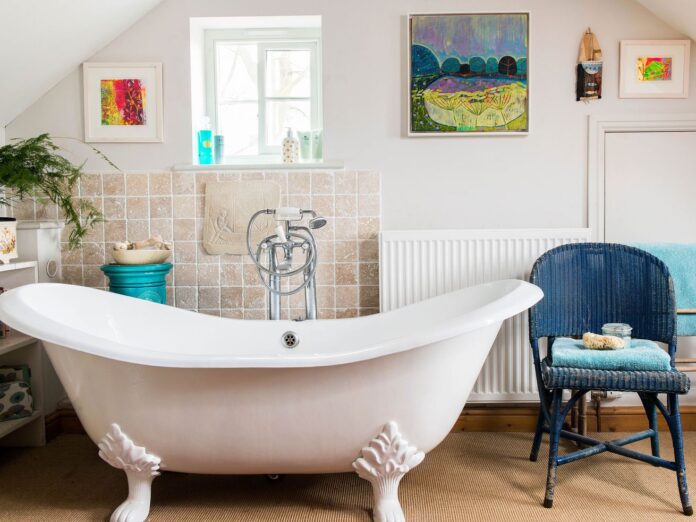[ad_1]

All it takes is one chip to detract from a porcelain tub’s clean, shiny allure. Luckily, fixing a chipped bathtub isn’t as difficult as it seems. Here’s how.
The porcelain coat on many tubs and sinks gives them a luxurious, clean look that few other materials can match. But, as a coating, it’s susceptible to chips and nicks. These dark specks of bare metal rob the tub of the luxurious feel it had when new. Luckily, it’s possible to repair these eyesores. The following guide on how to fix a chipped bathtub will help.
How to Fix a Chipped Bathtub
Note: The glossiness of the repair might not match the tub’s sheen perfectly. Continued sanding will help blend the repair, but it may still be possible to see a difference between the sheens.
Step 1: Match the tub’s color
The first step in fixing a chipped bathtub is to find a repair compound that matches the tub’s color. Bright white, off-white, black, and shades of almond and gray are standard. It’s important to get a compound to match the tub, and if your porcelain falls outside the typical range, color-matching products are available.
Step 2: Clean up
For the repair compound to stick to the metal, the area must be completely free of soap residue, skin oils, and other contaminants. Use the degreaser and sponge to clean the exposed metal, then dry the area with a clean, lint-free cloth. Next, apply painter’s tape around the outside of the chip. If the chip is on a vertical surface, be sure to apply extra tape underneath as the repair compound might run[SMK4] if accidentally applied too liberally.
Step 3: Mix the compound
For two-part compounds, open the lids of both parts and apply equal amounts of compound onto a scrap piece of cardboard. Mix the parts together with the mixing stick until the compound reaches an even color and consistency. Each kit should make several repairs, so don’t use it all at once.
For one-part repair compounds, be sure to mix the bottle contents according to the manufacturer’s instructions. This typically requires shaking the bottle, but it depends on the manufacturer.
Step 4: Apply the compound
Based on the consistency of the mixed compound, choose a paintbrush or plastic knife to apply it. Apply a thin layer to the bare metal and avoid pooling. This will prevent running, and though it will take more coats, it will actually take less time than puddling a lot of compound on the nick and waiting for it to dry.
Assess the color when applying the first coat. If it seems slightly off, it’s probably the metal showing through. However, stop and order another compound if it seems like the wrong color.
Step 5: Allow first coat to dry
Allow the first coat to dry according to the manufacturer’s instructions. Once dry, apply another thin coat and continue to repeat the process. The goal is to build thin layers of compound until the repaired surface is just slightly higher than the tub’s surface.
Step 6: Sand the edges
Once the repaired surface is dry and slightly higher than the tub’s, it’s time to sand. Remove the painter’s tape and spray the dried repair with the water bottle. Using ultra-fine sandpaper, sand the edges of the repair until they taper into the tub’s finish. Be sure to keep the sandpaper and repaired area wet with the spray bottle while sanding. Assess the repaired area with a bare hand, feel for ridges or high spots, and sand them smoothly.
Step 7: Repeat, if necessary
If there are still some sunken areas that need to be filled, repeat the process. Reapply painter’s tape around the repair area, mix a bit more compound, apply thin coats, and let it dry. Remove the tape and sand the repair to a smooth, even surface.
After a final sanding, the repaired area will be as well-blended as possible. It should be smooth to the touch, and the repair should be undetectable to the naked eye (though the sheen may still be slightly off). The repair should last for years to come, allowing you to get back to enjoying that luxurious, unblemished porcelain surface.
Note: It’s not recommended to wax any surface within a tub. This will make the tub, particularly a porcelain tub, very slippery. However, buffing the surface with a kitchen and bath polish might help make the tub sparkle and blend the repaired area; just be sure to let the repaired area dry for several days first.
Materials Needed
- Porcelain tub repair compound
- Degreaser and sponge
- Painter’s tape
- Mixing stick
- Small paintbrush or plastic putty knife
- Ultra-fine sandpaper (2,000 grit)
- Spray bottle
- Bath polish (optional)
[ad_2]
www.thisoldhouse.com










